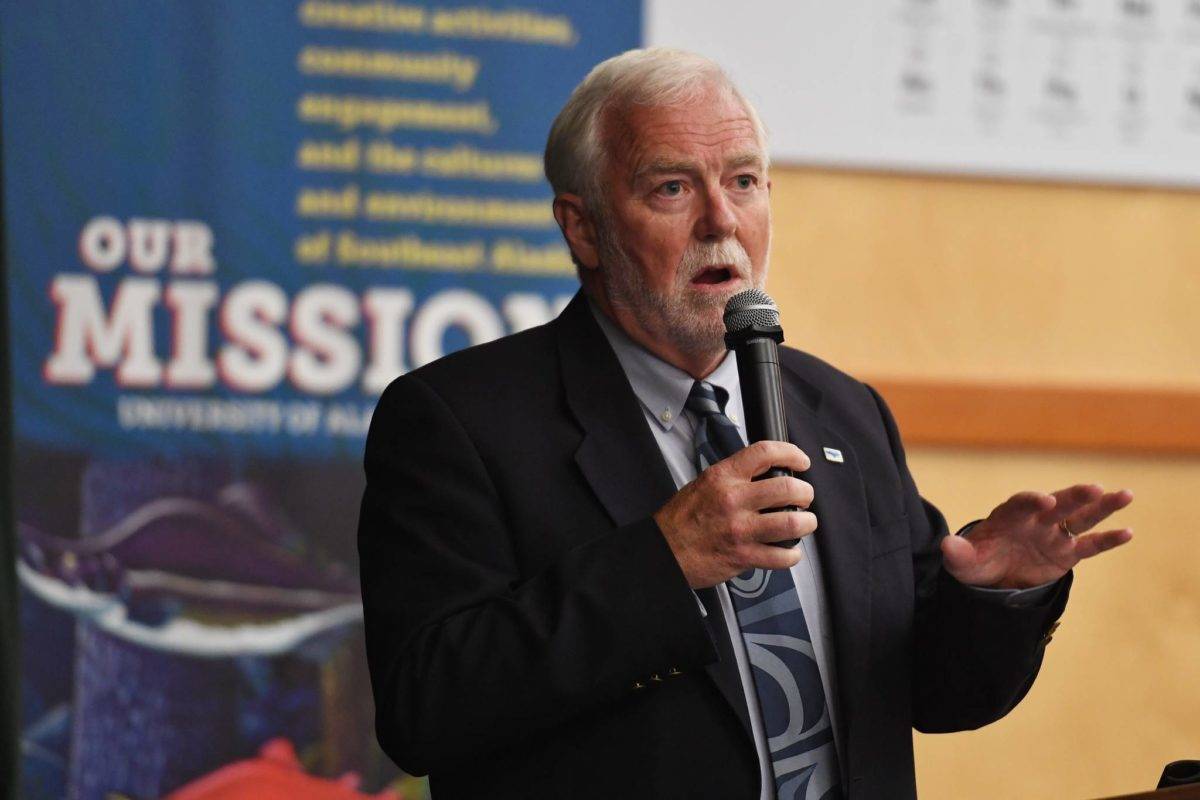The proposal to merge the University of Alaska Southeast with UA Fairbanks is troubling and should be a concern to businesses in Southeast Alaska, said UAS Chancellor Rick Caulfield Thursday in an address to the Greater Juneau Chamber of Commerce.
Speaking through video, Caulfield told the Chamber merging UAS with UAF would be likely to limit educational opportunities offered in Southeast and undermine long-standing workforce development relationships the university has with local businesses.
“It’s important to remember UAS has 299 totals employees at our three campuses. We have a payroll here in Southeast Alaska of $31 million, for Juneau that payroll is $24 million, the remainder in Sitka and Ketchikan,” Caulfield said. “In recent years, we’ve paid about $7 million annually to businesses and vendors at our campuses across Southeast. UAS is a significant part of our regional and local economies where our campuses are located.”
UAS has workforce development partnerships with Hecla Greens Creek Mine, Sealaska Heritage Institute and Bartlett Regional Hospital, Caulfield said, and he questions whether those programs could be sustained if university leadership was located in Fairbanks.
The UA system is suffering from a series of shocks recently as state budget cuts and the outbreak of COVID-19 have drastically reduced the university’s revenue. Then, last week, UA President Jim Johnsen announced his resignation.
Johnsen had been the only candidate for consideration for president of the University of Wisconsin but withdrew his name from consideration following criticism from faculty unions. University Vice President Michelle Rizk will serve as acting president until an interim president is named no later than July 15, according to the Associated Press.
[University of Alaska board votes for study on University of Alaska Southeast merger]
UAS has demonstrated the quality of its programs through ongoing accreditation, Caulfield said. UAS’ College of Education absorbed students from UA Anchorage when that university’s program lost its accreditation.
There were other ways to make cuts that didn’t sacrifice so many programs at UAS, Caulfield said, pointing to athletic programs which remain at UAA and UAF.
“I have nothing against athletics,” he said. “I’m just not sure the subsidies that provide for those programs are worth trading for workforce training programs.”
UAS receives 7.6% of state appropriations to the UA system, Caulfield said, and under the reductions proposed by Johnsen and the merger would mean substantial cuts to UAS. That would drastically change what UA is able to offer Southeast, according to Caulfield, and also mean significant reductions to local staff positions.
“Southeast students would have to shift largely to online courses emanating from Fairbanks,” he said. “I’m concerned about the impact that would have on the partnerships that we have for workforce development, whether that could be sustained if leadership is 700 miles away, you should be too.”
But UAS has received considerable support from the community, both financially and spiritually. Caulfield thanked the Chamber and many of its member organizations for their ongoing financial donations and said he was heartened to hear so many people give public testimony in support of leaving UAS as an independent entity.
“Despite all of that heartening support, the (UA Board of Regents) went ahead and called for a formal study, and asked that a report be prepared and presented before the Board of Regents meeting in November,” Caulfield said.
[University of Alaska president resigns]
He was disappointed the merger option was the only one to get close consideration, he said, even though there were other options available. When Johnsen announced the merger plan June 1, he said these options had been chosen with limited time and other options were available but at a June 4, Regents meeting an in-depth study of the merger was ordered.
Caulfield, too, is leaving the UA system, but he’s going to remain in Juneau, he said during his talk. He intends to continue his advocacy for UAS into his retirement, he said, and in some ways, being a private citizen will allow him to become more of an advocate.
The University announced Wednesday UAS Provost Karen Carey would serve as interim chancellor of the school until a decision is made about the school.
“Dr. Carey’s extensive experience with UAS, her distinguished career as an academic leader and her love for the university makes me confident that she will be a strong leader and will do an outstanding job as Interim Chancellor,” Rizk said in a letter.
Despite all the uncertainty, UAS will be open for the fall, Caulfield said, and the school is currently planning to hold in-person classes and offer limited student housing with additional health precautions.
• Contact reporter Peter Segall at psegall@juneauempire.com. Follow him on Twitter at @SegallJnoEmpire.

